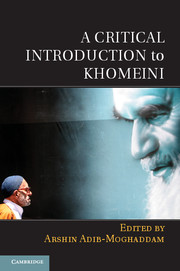Book contents
- Frontmatter
- Contents
- List of Map and Figures
- About the Authors
- Acknowledgments
- Glossary
- Timeline: The Life of Ayatollah Ruhollah Khomeini (1902–1989)
- Introduction Ayatollah Ruhollah Khomeini: A Clerical Revolutionary?
- 1 Khomeini and the “White Revolution”
- 2 The Rise of Khomeinism
- 3 Wilayat al-Faqih and the Meaning of Islamic Government
- 4 Ayatollah Khomeini’s Rule of the Guardian Jurist
- 5 Khatt-e Imam
- 6 Khomeini and the West
- 7 Gendered Khomeini
- 8 Hidden Khomeini
- 9 The Divine, the People, and the Faqih
- 10 Khomeini’s Legacy on Women’s Rights and Roles in the Islamic Republic of Iran
- 11 To Rule, or Not to Rule? An Alternative Look at the Political Life of Ayatollah Khomeini between 1960 and 1980
- 12 Khomeini and the Decolonization of the Political
- 13 Contentious Legacies of the Ayatollah
- Further Reading
- Index
- References
13 - Contentious Legacies of the Ayatollah
Published online by Cambridge University Press: 05 June 2014
- Frontmatter
- Contents
- List of Map and Figures
- About the Authors
- Acknowledgments
- Glossary
- Timeline: The Life of Ayatollah Ruhollah Khomeini (1902–1989)
- Introduction Ayatollah Ruhollah Khomeini: A Clerical Revolutionary?
- 1 Khomeini and the “White Revolution”
- 2 The Rise of Khomeinism
- 3 Wilayat al-Faqih and the Meaning of Islamic Government
- 4 Ayatollah Khomeini’s Rule of the Guardian Jurist
- 5 Khatt-e Imam
- 6 Khomeini and the West
- 7 Gendered Khomeini
- 8 Hidden Khomeini
- 9 The Divine, the People, and the Faqih
- 10 Khomeini’s Legacy on Women’s Rights and Roles in the Islamic Republic of Iran
- 11 To Rule, or Not to Rule? An Alternative Look at the Political Life of Ayatollah Khomeini between 1960 and 1980
- 12 Khomeini and the Decolonization of the Political
- 13 Contentious Legacies of the Ayatollah
- Further Reading
- Index
- References
Summary
“The political system established by Khomeini,” the late Fred Halliday once remarked, “has endured, combining, in a way that no other modern revolution has been able to do, elements of unelected revolutionary power and a democratically elected leadership.” Halliday, a leading academic of revolutions and an astute student of Iranian politics, made this observation in response to the 1999 student uprising, the most violent political protests in post-revolutionary period in Iran to that day. Ten years later, Iran was to witness another historic popular uprising, even larger than the 1999 protests, in weeks following the presidential elections of June 2009, whose results in favor of the incumbent president, Mahmoud Ahmadinejad, provoked massive protests in major cities around the country. At the threshold of another tightly controlled election, the Islamic Republic had experienced its most serious crisis of political legitimacy to date, and yet it had survived.
Sadly, Halliday died in 2010. But if he were able to witness the course of Iranian politics in the post-election period, he would not have been too surprised to learn about the tension that unfolded between Ahmadinejad, now despised by many conservatives for his defiance of the elite establishment, and the Supreme Leader, Ayatollah Ali Khamenei, nearly two years after the 2009 elections. He would have, I imagine, described such conflict as a major ideological struggle over who can best rule over the Islamic government, and an ideological tension reflecting a deeper contradiction within the political structure of the Islamic Republic; a conflict between the vali-ye faqih (Guardian Jurist) as an unelected office and the executive branch as an elected institution.
- Type
- Chapter
- Information
- A Critical Introduction to Khomeini , pp. 291 - 306Publisher: Cambridge University PressPrint publication year: 2014
References
- 3
- Cited by



